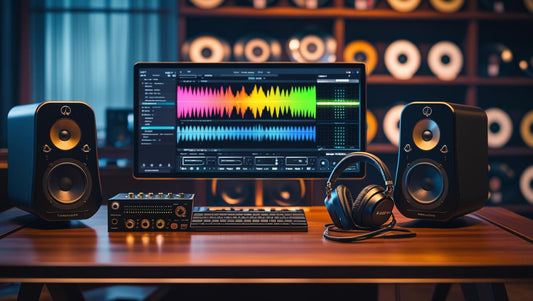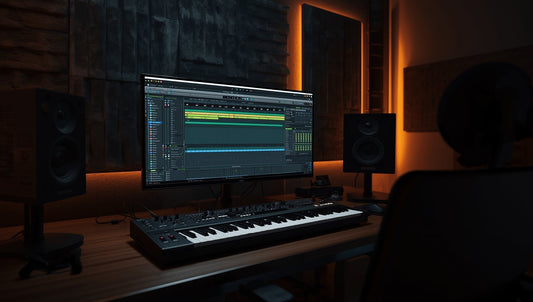How to Tune Drums for That Classic Breakbeat Sound in Hip-Hop

If you're aiming to capture that classic breakbeat sound that has defined hip-hop's golden era, drum tuning is your secret weapon. The tight, punchy tones reminiscent of James Brown's legendary grooves are not only achievable but essential for any drummer-producer looking to elevate their tracks. By embracing a minimal mic philosophy, you can naturally capture the rich, full-bodied sound that icons like Questlove and Pete Rock have mastered. With just a couple of strategically placed microphones, you can harness the power of vintage recording techniques, creating a soundscape that's both authentic and dynamic. Join us as we explore the art of drum tuning, mic placement, and minimalism to transform your beats into timeless classics.

Tuning for Classic Breakbeat Sound
Achieving that iconic breakbeat sound starts with proper drum tuning. Let's dive into the techniques that will give your drums that punchy, vintage tone reminiscent of hip-hop's golden era.
Snare and Bass Drum Techniques
The snare and bass drum form the backbone of any breakbeat. For that classic sound, you'll want to focus on achieving a tight, high-pitched tone.
Start with the snare. Use bright heads like Remo Ambassadors or Diplomats. Tune the snare high and tight, aiming for a crisp, cutting sound that cuts through the mix. Adjust the wire tension to enhance the snap without choking the drum's resonance.
For the bass drum, contrary to modern techniques, aim for a higher tuning. Remove the front head or cut a small hole in it. This allows for better mic placement and control over the drum's resonance. Consider muffling with a pillow or blanket to tighten up the sound.
Remember, the goal is to create a punchy, focused sound that forms a solid foundation for your breakbeat.
Tom Tuning for Vintage Tone
Toms play a crucial role in creating that vintage breakbeat sound. The key is to tune them high, creating a melodic interplay with your snare and kick.
Aim to tune your toms in intervals of fourths or thirds. This creates a musical relationship between the drums, enhancing the overall groove. For that authentic 70s sound, try tuning the resonant heads slightly tighter than the batter heads.
Experiment with different tuning combinations until you find the sweet spot that complements your snare and kick. The goal is to achieve a cohesive kit sound that's both punchy and melodic, perfect for those classic hip-hop breaks.
Minimal Mic Techniques
When it comes to capturing that authentic breakbeat sound, less is often more. Let's explore how minimal mic setups can help you achieve a rich, full-bodied drum sound.
Questlove's Minimalist Approach
Questlove, drummer for The Roots and a renowned producer, is famous for his minimalist approach to drum miking. His technique is a masterclass in capturing a natural, vintage drum sound.
Typically, Questlove uses just two microphones: one on the kick drum and one overhead to capture the full kit tone. For the overhead, he often prefers the Coles 4038 ribbon mic, known for its warm, natural sound.
This minimalist setup allows the drums to breathe and interact naturally with the room acoustics. It captures the kit as a cohesive whole, rather than as isolated elements, resulting in a more organic, vintage-style sound.

Historical Mic Setup Examples
Looking back at classic recordings can provide valuable insights into effective minimal mic techniques. One of the most famous examples is Led Zeppelin's "When the Levee Breaks."
This iconic drum sound was achieved using just two Beyerdynamic M160 ribbon mics placed at the top of a stairwell at Headley Grange. The natural reverb of the stairwell, combined with the warm characteristics of the ribbon mics, created the massive, room-filling sound we all know and love.
The recording was then processed through Helios compressors and a Binson Echorec echo unit, further enhancing its unique character. This example perfectly illustrates how a great room and minimal mic setup can capture a massive, timeless drum sound.

Compression & Mixing Strategies
Once you've captured your drum sound, the next step is to shape it in the mix. Let's explore some compression and mixing techniques that can help you achieve that classic breakbeat sound.
Gentle Compression Techniques
Compression is key to achieving that punchy, in-your-face breakbeat sound. However, the key is to use it judiciously to enhance the natural dynamics of the drums.
Start with gentle compression on your room and overhead mics. A good starting point is to use a ratio of 4:1 with a slow attack and fast release. This will help to control peaks without squashing the life out of your drums.
For individual drums, consider using parallel compression. This technique involves blending a heavily compressed version of the drum with the original signal, allowing you to add punch while maintaining the natural attack and decay of the drum.
Remember, the goal is to enhance the natural sound of the drums, not to over-process them. Let the tuning and mic placement do most of the work.
Emphasizing Natural Resonance
To truly capture that vintage breakbeat sound, it's crucial to let the natural resonance of the drums shine through in the mix. This means being judicious with EQ and allowing some of the room sound to come through.
Start by listening to the raw drum tracks and identifying the frequencies that give each drum its character. Use subtle EQ boosts to enhance these frequencies rather than trying to dramatically reshape the sound.
When it comes to effects, less is often more. A touch of tape saturation can add warmth and cohesion to your drum bus. Experiment with short room reverbs to add depth without washing out the drums.
Finally, don't be afraid of a little bleed between mics. This interaction between drums is part of what gives classic breaks their organic feel. Embrace it as part of your sound rather than trying to eliminate it completely.
No comments








0 comments